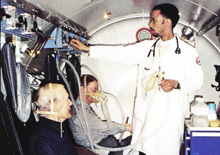
patients in hyperbaric chamber at
Jacobi Medical Center.
Ivan Tirado is a diabetic and after doctors amputated a toe from his left foot because of the disease, Tirado’s foot wounds wouldn’t heal and he couldn’t walk. He stayed isolated at home all day and got very depressed.
But after five months of “diving” in the Jacobi Medical Center Hyperbaric Chamber, Tirado is a new man.
“I have improved so much that I take much better care of myself and can walk outside for exercise again,” Tirado said.
Hyperbaric oxygen therapy (HBOT) was originally developed to treat divers experiencing disorders such as “the bends,” or decompression sickness. Over time, HBOT has been more commonly used for a number of conditions such as carbon monoxide poisoning, smoke inhalation, and delayed radiation injury.
But doctors at Jacobi and other medical centers around the country have discovered that the treatment also works to heal difficult wounds like those that result from diabetes. Fifty percent of all lower extremity amputations in the U.S. are due to diabetes. And many diabetics suffer circulatory disorders that create inadequate levels of oxygen to support healing of those wounds.
“Diabetic wound care is a major challenge,” said Dr. Jessica Wang, Director of Hyperbaric Medicine at Jacobi. “The disease causes poor blood flow to the extremities. Increasing oxygenation brings white blood cells to the wound and causes new blood vessels to grow in the area, which aids in healing.”
Five days a week, Tirado underwent two-hour HBOT treatments, which involved exposing his entire body, in the 9-foot-long chamber, with 100-percent oxygen at greater than normal atmospheric pressures. The elevation in tissue oxygen that occurs in the hyperbaric chamber promotes faster healing. Because of its original use, the term for a cycle of pressurization inside the HBOT chamber is called a dive and patients are considered divers.
“Do you remember the movie Journey to the Bottom of the Sea?” Tirado said. “That’s what I thought of when I saw Jacobi’s hyperbaric chamber for the first time. I said, Wow, I’m going into a submarine. And when the staff said ‘immersion’ and began to pressurize the chamber my ears popped.”
The hyperbaric chamber can comfortably accommodate eight patients. Doctors at Jacobi have treated 100 diabetic patients and the team hopes to care for many more as more doctors and patients learn about the treatment. They treat a total of about 1,300 patients per year and about 35 patients per month.
“Since my treatments so many things have changed for me. My feet and legs don’t swell anymore and my lungs are clear. Because I have enough oxygen in my blood now, my whole body is healing,” Tirado said.
All patients who undergo HBOT treatment must be referred by a physician. For information about hyperbaric treatment at Jacobi call 718-918-7520 .

